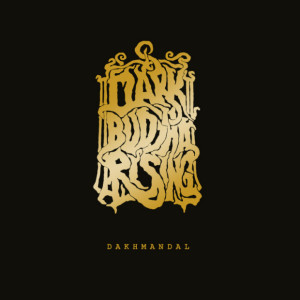Dark Buddha Rising – Dakhmandal | Review
Jayaprakash Satyamurthy reviews the new album from Dark Buddha Rising titled Dakhmandal, released via Svart Records.
Tracklisting:
1. D
2. K
3. H
4. M
5. N
6. L
Mark your calendars: June 7th, 2013 is going to be the day a new highwater mark is achieved in the drone/doom/sludge space. That’s the day Dark Buddha Rising’s new album, ‘Dakhmandal’ drops.
Few artists emerging from this space have made this kind of impact on me since, oh Orthodox and Khanate before them. When I first heard of Dark Buddha Rising, I assumed they’d be a slightly kraut-y, psychedelic/stoner jam outfit like the excellent but very different My Sleeping Karma. If you need to take a moment to shake your head in dismay at the shallowness of my thought processes, go ahead, I’ll wait. Oh good, you’re back. Well, when I heard Dark Buddha Rising’s previous album, 2011’s ‘Abyssolute Transfinite’, I realized how wrong I was. This is hermetic music, obscure and even oppressive, yet with a compelling, mesmeric atmosphere. Sparse, deconstructed passages co-exist with supermassive, dense sequences that feel like sludge metal played inside a black hole. The final impression is one of incredible heaviness, but in a ritualistic and leftfield manner.
Dakhmandal ably carries on with the band’s campaign of esoteric sonic persecution, refining it to a new peak of majesty and authority. This is completely uncompromising music, music that you have to work towards understanding, and that can be an incredibly refreshing experience after the wash of US sludge bands miming the sounds of post-peak Mastodon or Baroness. If you’re at all into heavy music, you don’t always want to be pulled along by hooks, accessible melodies and catchy vocals. Sometimes you need to listen to music that is shaped by individualism, integrity and some very twisted yet absolutely brilliant and original sensibilities.
If so, the cycle of songs on this album will serve as a series of destinations on a grueling but rewarding sonic journey. These songs may well stand on their own, but it’s clear that they were meant to be listened to as a suite.
[soundcloud url=”http://api.soundcloud.com/tracks/87155451″ params=”color=e0df13&auto_play=false&show_artwork=true” width=” 100%” height=”166″ iframe=”true” /]
The opening song, ‘D’ begins with the faintest hints of sound – the stray feedback artifact, a distant almost-drone that keens to itself in darkness. Three minutes in, a simple bass pulse emerges out of this mysterious soundscape. The ritual has begun. Melody starts to insinuate itself, ever so subtly, into this realm of antediluvian rhythm and drone. The claustral atmosphere opens out, as if we’re emerging from a cave into bright starlight, into the kind of atmosphere created by an Om song. ‘K’ plunges us into the world of craggy, overdriven guitars and sludgy riffs. Hollow, incantatory vocals invite us deeper into the mysteries of an unfolding catechism. The song shifts gear into a drawn-out spacey, downtempo jam before building up to a sludgy finale. ‘H’ is another serving of mountainous riffs, moving at geological speed, like a slightly less ponderous Khanate. Aggressive stasis defines this song, as opposed to the shifting musical textures of the previous tracks. This is a Sargasso Sea of sound that is eventually swallowed in mist and squall. ‘M’ strips away the sludge metal appurtenances to take us into a vaulted chamber where a mutated organ vies with other droning layers. Then, a simple, pulsating guitar melody signals a shift into something that I can best describe as shamanic. Seriously, nevermind the Morrison bollocks, this is the real deal. At times, the warm, sunshiny, mystical feel of this song reminds me of those masters of the drone, Earth, but more occult and less Cormac McCarthy. The spirits have certainly been invited to this feast. The song closes out with some wall-to-wall riffing and vocals that are reminiscent of Yob’s more mantra-like moments. ‘N’ continues mine the same vein of monumental riffs, cavernous atmosphere and transcendental sludge. How do you close out an album like this? The last track, ‘L’ takes its time coalescing out of a wash of feedback and almost disjointed drumming. Ominous, fervent vocal proclamations issue from a preacher’s pulpit, but one that is obviously stationed in some cavernous subterranean cathedral to an unknown deity. Distant, soaring choruses float behind veils of sheer noise – and then there’s a simple, insistent groove which emerges as a focus for a pulsing, hypnotic song with weird chants and harsh invocations hovering just out of reach. It’s a monumental ending, full of restraint, power and an unusual widdershins grace.
Some have described this music as dirge-like, but I think it’s more than that. Something is being celebrated here, but it is not of the daylit world we imagine we inhabit. This is bigger than Satanism or paganism. It’s an initiation into the mysteries of the sonic arcana. After three self-released albums, this is Dark Buddha Rising’s first album to be released by an external label – Svart Records. Credit is due to Svart for having the vision to take on this 80-minute exercise in sound as ritual. This is a band and a record that deserves a wider audience, although the uncompromising intensity and uniqueness of their sound necessarily imposes a limit on that audience.
Sanath Kumar
Latest posts by Sanath Kumar (see all)
- Vader and Soilwork to perform at Bangalore Open Air 2016 - June 7, 2015
- Chris Adler likely to quit Lamb of God after joining Megadeth - March 31, 2015
- Chris Adler is the new Megadeth Drummer [CONFIRMED] - March 29, 2015
Related Posts
« NVRVD – Coma | Review Diamonds in the Rough – April – Part I »










